Managing Innovation: Application of Theories in Company Development
VerifiedAdded on 2023/01/12
|11
|3692
|55
Report
AI Summary
This report analyzes the application of innovation theories, specifically the Diffusion of Innovation (DOI) and Disruptive Innovation theories, within the context of Made.com, an online furniture retailer. The report defines and explains both DOI, detailing its principles, processes, and evaluation, and Disruptive Innovation, outlining its definitions, principles, processes, and benefits/limitations. It then provides a comprehensive company background of Made.com, highlighting its historical development and the innovative use of NFC technology in its stores to enhance customer experience and gain a competitive edge. The analysis includes how Made.com has applied these innovation theories to foster growth, improve customer engagement, and personalize shopping experiences through the use of technology. Finally, the report discusses the application of these theories in the context of future development for Made.com.
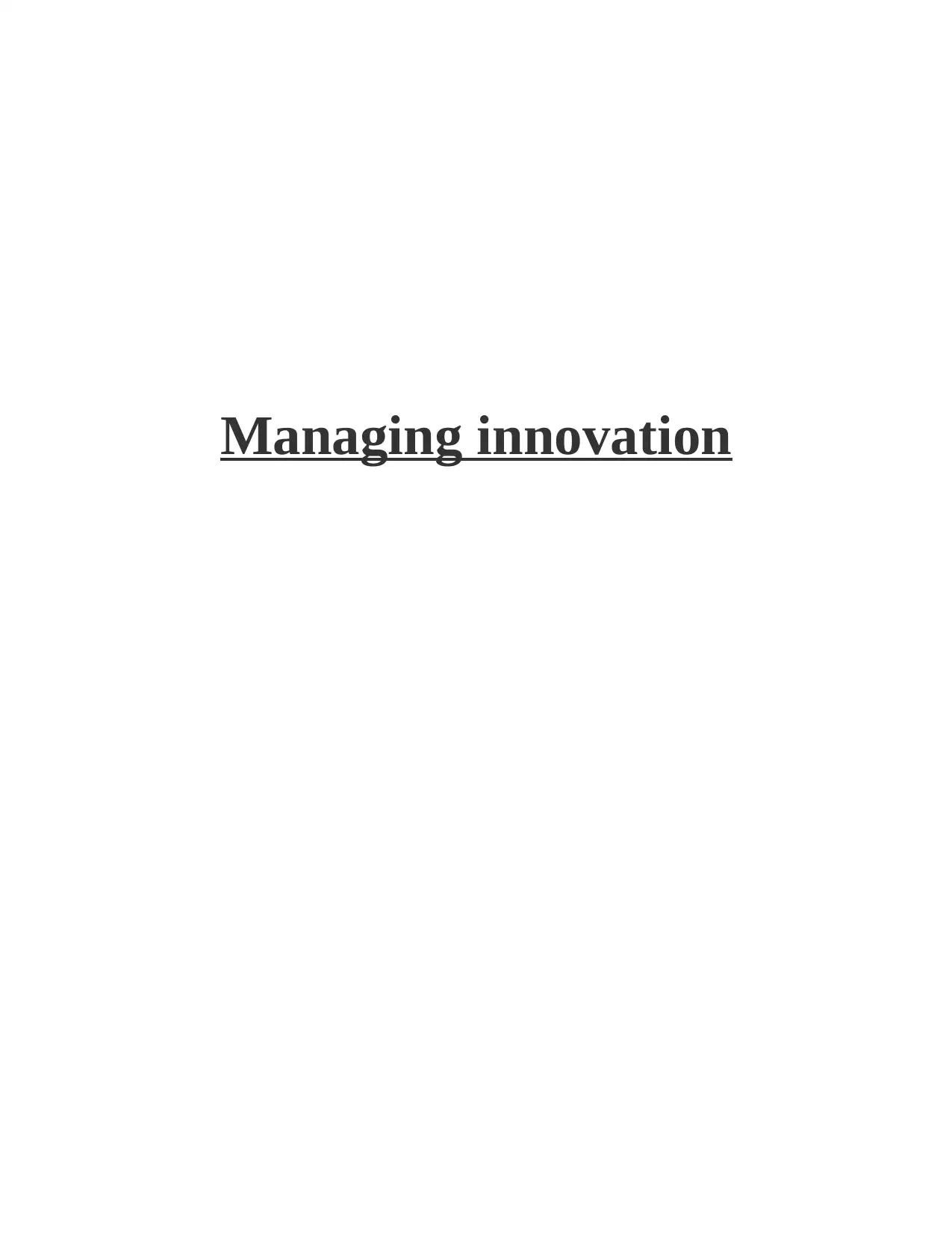
Managing innovation
Paraphrase This Document
Need a fresh take? Get an instant paraphrase of this document with our AI Paraphraser
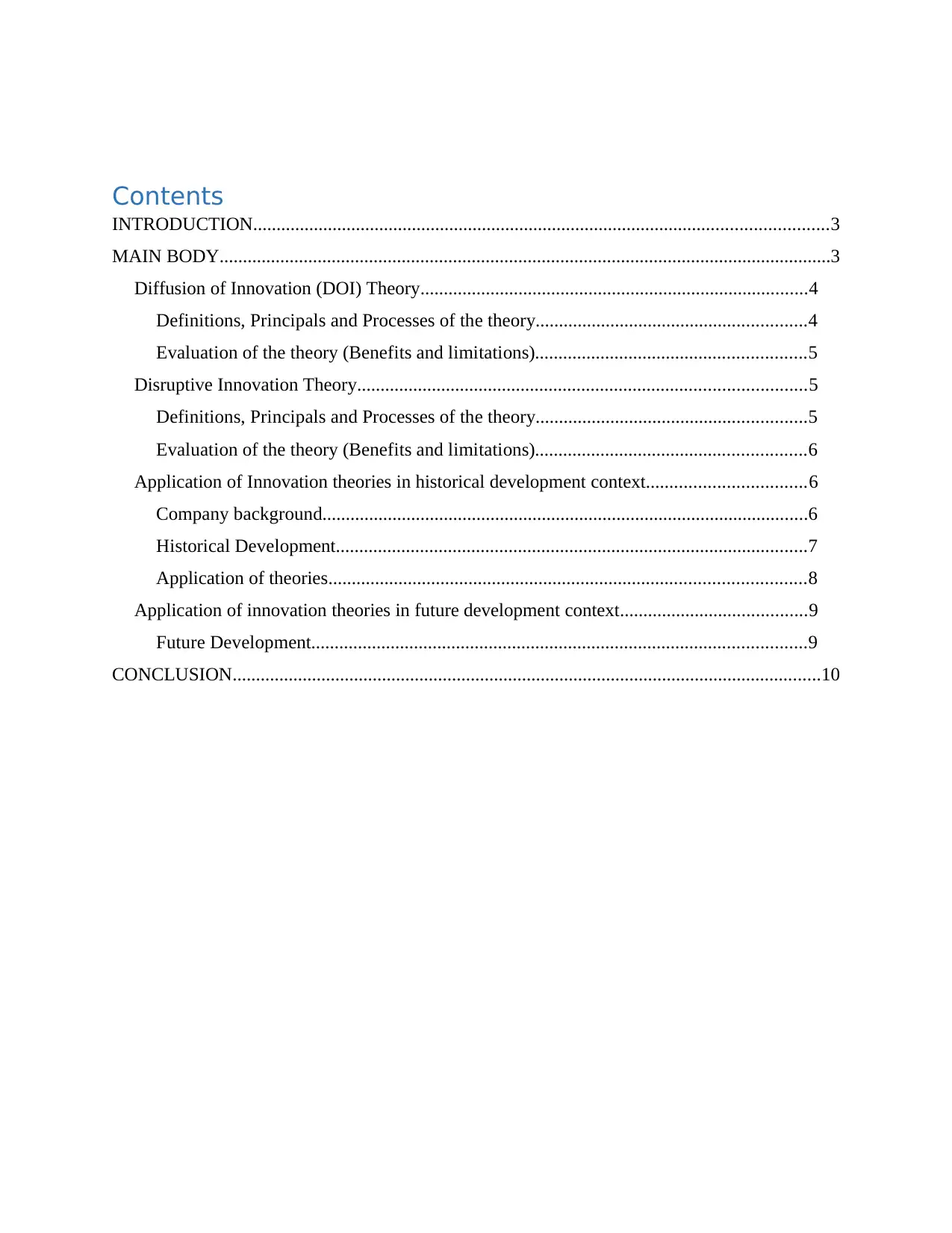
Contents
INTRODUCTION...........................................................................................................................3
MAIN BODY...................................................................................................................................3
Diffusion of Innovation (DOI) Theory...................................................................................4
Definitions, Principals and Processes of the theory..........................................................4
Evaluation of the theory (Benefits and limitations)..........................................................5
Disruptive Innovation Theory................................................................................................5
Definitions, Principals and Processes of the theory..........................................................5
Evaluation of the theory (Benefits and limitations)..........................................................6
Application of Innovation theories in historical development context..................................6
Company background........................................................................................................6
Historical Development.....................................................................................................7
Application of theories......................................................................................................8
Application of innovation theories in future development context........................................9
Future Development..........................................................................................................9
CONCLUSION..............................................................................................................................10
INTRODUCTION...........................................................................................................................3
MAIN BODY...................................................................................................................................3
Diffusion of Innovation (DOI) Theory...................................................................................4
Definitions, Principals and Processes of the theory..........................................................4
Evaluation of the theory (Benefits and limitations)..........................................................5
Disruptive Innovation Theory................................................................................................5
Definitions, Principals and Processes of the theory..........................................................5
Evaluation of the theory (Benefits and limitations)..........................................................6
Application of Innovation theories in historical development context..................................6
Company background........................................................................................................6
Historical Development.....................................................................................................7
Application of theories......................................................................................................8
Application of innovation theories in future development context........................................9
Future Development..........................................................................................................9
CONCLUSION..............................................................................................................................10
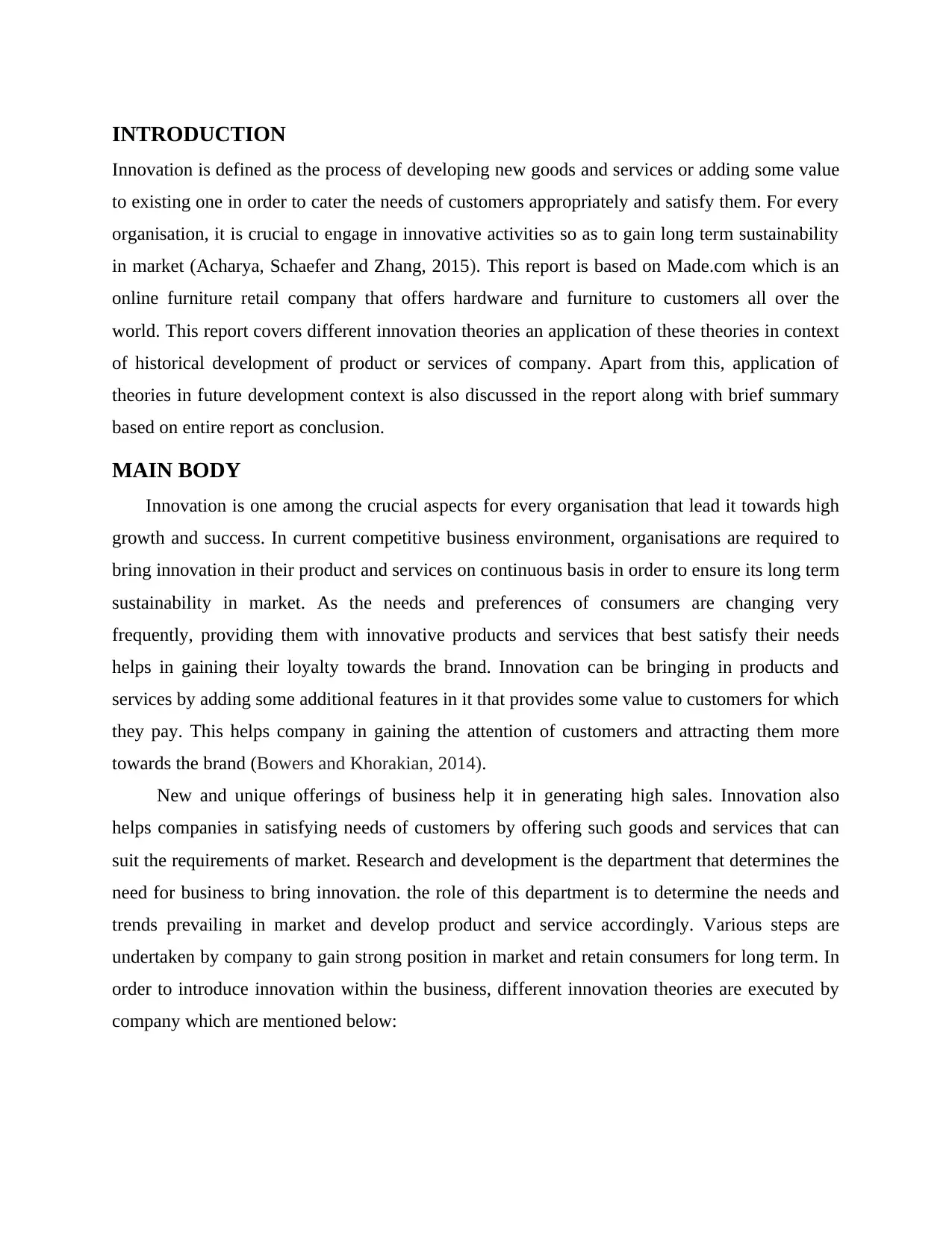
INTRODUCTION
Innovation is defined as the process of developing new goods and services or adding some value
to existing one in order to cater the needs of customers appropriately and satisfy them. For every
organisation, it is crucial to engage in innovative activities so as to gain long term sustainability
in market (Acharya, Schaefer and Zhang, 2015). This report is based on Made.com which is an
online furniture retail company that offers hardware and furniture to customers all over the
world. This report covers different innovation theories an application of these theories in context
of historical development of product or services of company. Apart from this, application of
theories in future development context is also discussed in the report along with brief summary
based on entire report as conclusion.
MAIN BODY
Innovation is one among the crucial aspects for every organisation that lead it towards high
growth and success. In current competitive business environment, organisations are required to
bring innovation in their product and services on continuous basis in order to ensure its long term
sustainability in market. As the needs and preferences of consumers are changing very
frequently, providing them with innovative products and services that best satisfy their needs
helps in gaining their loyalty towards the brand. Innovation can be bringing in products and
services by adding some additional features in it that provides some value to customers for which
they pay. This helps company in gaining the attention of customers and attracting them more
towards the brand (Bowers and Khorakian, 2014).
New and unique offerings of business help it in generating high sales. Innovation also
helps companies in satisfying needs of customers by offering such goods and services that can
suit the requirements of market. Research and development is the department that determines the
need for business to bring innovation. the role of this department is to determine the needs and
trends prevailing in market and develop product and service accordingly. Various steps are
undertaken by company to gain strong position in market and retain consumers for long term. In
order to introduce innovation within the business, different innovation theories are executed by
company which are mentioned below:
Innovation is defined as the process of developing new goods and services or adding some value
to existing one in order to cater the needs of customers appropriately and satisfy them. For every
organisation, it is crucial to engage in innovative activities so as to gain long term sustainability
in market (Acharya, Schaefer and Zhang, 2015). This report is based on Made.com which is an
online furniture retail company that offers hardware and furniture to customers all over the
world. This report covers different innovation theories an application of these theories in context
of historical development of product or services of company. Apart from this, application of
theories in future development context is also discussed in the report along with brief summary
based on entire report as conclusion.
MAIN BODY
Innovation is one among the crucial aspects for every organisation that lead it towards high
growth and success. In current competitive business environment, organisations are required to
bring innovation in their product and services on continuous basis in order to ensure its long term
sustainability in market. As the needs and preferences of consumers are changing very
frequently, providing them with innovative products and services that best satisfy their needs
helps in gaining their loyalty towards the brand. Innovation can be bringing in products and
services by adding some additional features in it that provides some value to customers for which
they pay. This helps company in gaining the attention of customers and attracting them more
towards the brand (Bowers and Khorakian, 2014).
New and unique offerings of business help it in generating high sales. Innovation also
helps companies in satisfying needs of customers by offering such goods and services that can
suit the requirements of market. Research and development is the department that determines the
need for business to bring innovation. the role of this department is to determine the needs and
trends prevailing in market and develop product and service accordingly. Various steps are
undertaken by company to gain strong position in market and retain consumers for long term. In
order to introduce innovation within the business, different innovation theories are executed by
company which are mentioned below:
⊘ This is a preview!⊘
Do you want full access?
Subscribe today to unlock all pages.

Trusted by 1+ million students worldwide
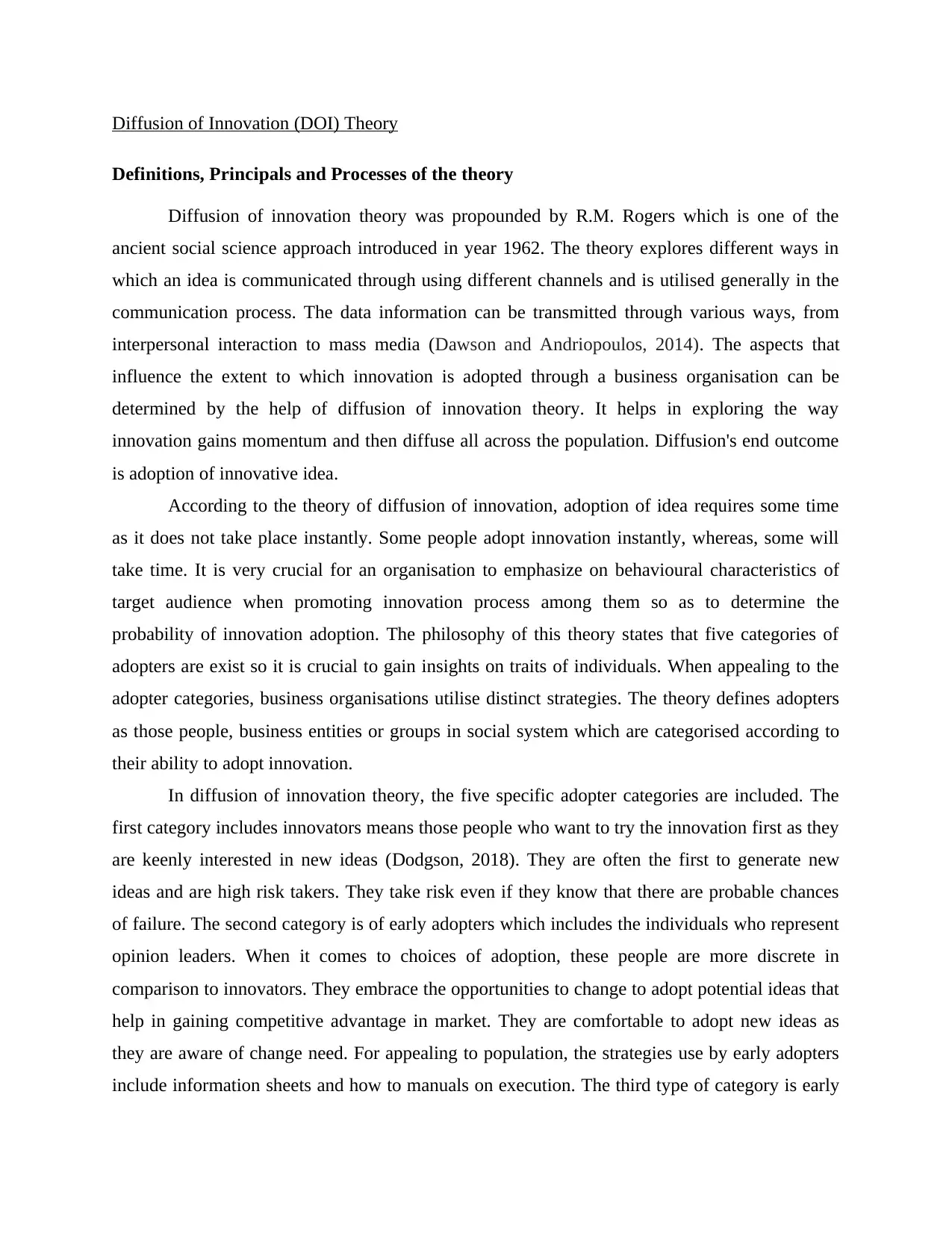
Diffusion of Innovation (DOI) Theory
Definitions, Principals and Processes of the theory
Diffusion of innovation theory was propounded by R.M. Rogers which is one of the
ancient social science approach introduced in year 1962. The theory explores different ways in
which an idea is communicated through using different channels and is utilised generally in the
communication process. The data information can be transmitted through various ways, from
interpersonal interaction to mass media (Dawson and Andriopoulos, 2014). The aspects that
influence the extent to which innovation is adopted through a business organisation can be
determined by the help of diffusion of innovation theory. It helps in exploring the way
innovation gains momentum and then diffuse all across the population. Diffusion's end outcome
is adoption of innovative idea.
According to the theory of diffusion of innovation, adoption of idea requires some time
as it does not take place instantly. Some people adopt innovation instantly, whereas, some will
take time. It is very crucial for an organisation to emphasize on behavioural characteristics of
target audience when promoting innovation process among them so as to determine the
probability of innovation adoption. The philosophy of this theory states that five categories of
adopters are exist so it is crucial to gain insights on traits of individuals. When appealing to the
adopter categories, business organisations utilise distinct strategies. The theory defines adopters
as those people, business entities or groups in social system which are categorised according to
their ability to adopt innovation.
In diffusion of innovation theory, the five specific adopter categories are included. The
first category includes innovators means those people who want to try the innovation first as they
are keenly interested in new ideas (Dodgson, 2018). They are often the first to generate new
ideas and are high risk takers. They take risk even if they know that there are probable chances
of failure. The second category is of early adopters which includes the individuals who represent
opinion leaders. When it comes to choices of adoption, these people are more discrete in
comparison to innovators. They embrace the opportunities to change to adopt potential ideas that
help in gaining competitive advantage in market. They are comfortable to adopt new ideas as
they are aware of change need. For appealing to population, the strategies use by early adopters
include information sheets and how to manuals on execution. The third type of category is early
Definitions, Principals and Processes of the theory
Diffusion of innovation theory was propounded by R.M. Rogers which is one of the
ancient social science approach introduced in year 1962. The theory explores different ways in
which an idea is communicated through using different channels and is utilised generally in the
communication process. The data information can be transmitted through various ways, from
interpersonal interaction to mass media (Dawson and Andriopoulos, 2014). The aspects that
influence the extent to which innovation is adopted through a business organisation can be
determined by the help of diffusion of innovation theory. It helps in exploring the way
innovation gains momentum and then diffuse all across the population. Diffusion's end outcome
is adoption of innovative idea.
According to the theory of diffusion of innovation, adoption of idea requires some time
as it does not take place instantly. Some people adopt innovation instantly, whereas, some will
take time. It is very crucial for an organisation to emphasize on behavioural characteristics of
target audience when promoting innovation process among them so as to determine the
probability of innovation adoption. The philosophy of this theory states that five categories of
adopters are exist so it is crucial to gain insights on traits of individuals. When appealing to the
adopter categories, business organisations utilise distinct strategies. The theory defines adopters
as those people, business entities or groups in social system which are categorised according to
their ability to adopt innovation.
In diffusion of innovation theory, the five specific adopter categories are included. The
first category includes innovators means those people who want to try the innovation first as they
are keenly interested in new ideas (Dodgson, 2018). They are often the first to generate new
ideas and are high risk takers. They take risk even if they know that there are probable chances
of failure. The second category is of early adopters which includes the individuals who represent
opinion leaders. When it comes to choices of adoption, these people are more discrete in
comparison to innovators. They embrace the opportunities to change to adopt potential ideas that
help in gaining competitive advantage in market. They are comfortable to adopt new ideas as
they are aware of change need. For appealing to population, the strategies use by early adopters
include information sheets and how to manuals on execution. The third type of category is early
Paraphrase This Document
Need a fresh take? Get an instant paraphrase of this document with our AI Paraphraser
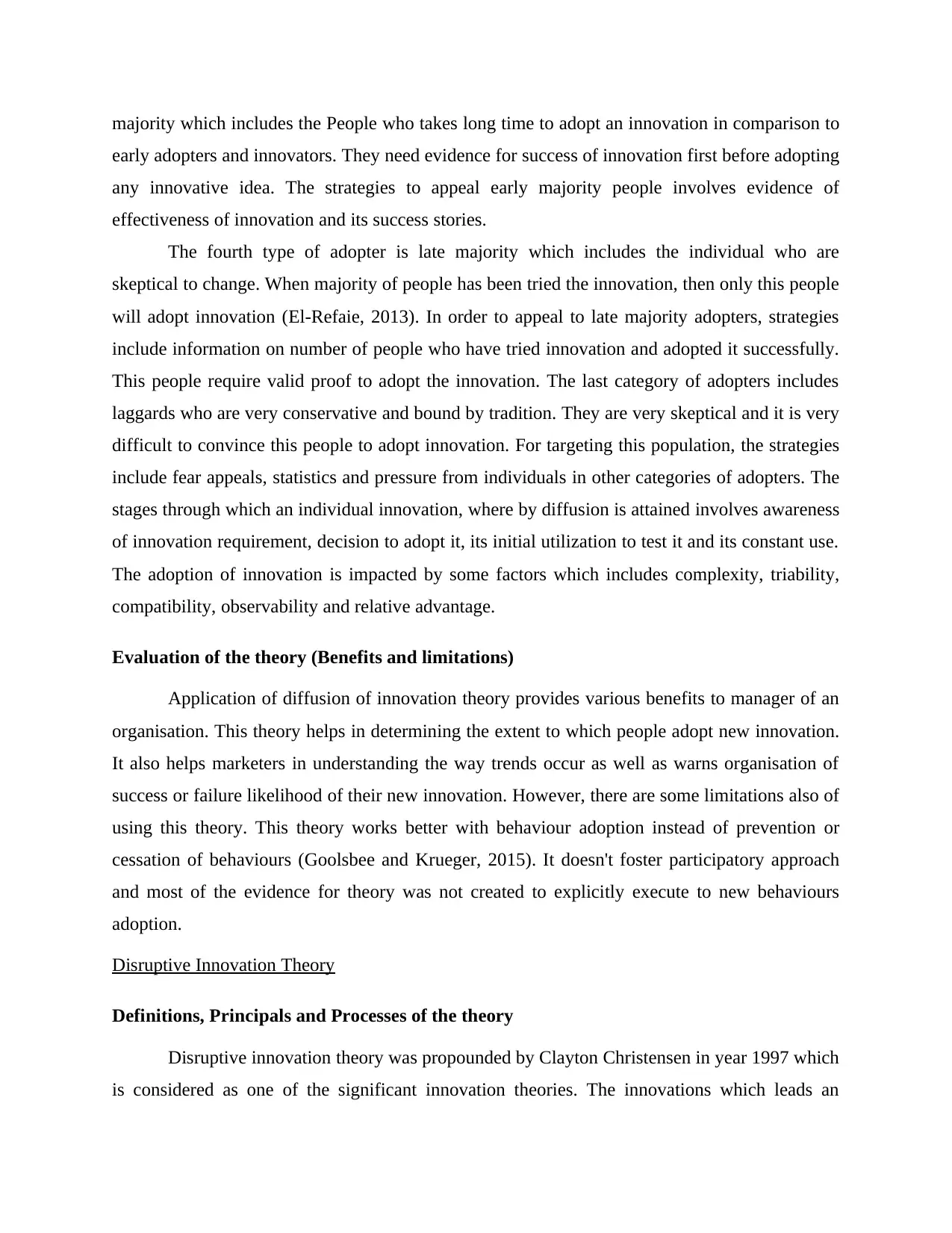
majority which includes the People who takes long time to adopt an innovation in comparison to
early adopters and innovators. They need evidence for success of innovation first before adopting
any innovative idea. The strategies to appeal early majority people involves evidence of
effectiveness of innovation and its success stories.
The fourth type of adopter is late majority which includes the individual who are
skeptical to change. When majority of people has been tried the innovation, then only this people
will adopt innovation (El-Refaie, 2013). In order to appeal to late majority adopters, strategies
include information on number of people who have tried innovation and adopted it successfully.
This people require valid proof to adopt the innovation. The last category of adopters includes
laggards who are very conservative and bound by tradition. They are very skeptical and it is very
difficult to convince this people to adopt innovation. For targeting this population, the strategies
include fear appeals, statistics and pressure from individuals in other categories of adopters. The
stages through which an individual innovation, where by diffusion is attained involves awareness
of innovation requirement, decision to adopt it, its initial utilization to test it and its constant use.
The adoption of innovation is impacted by some factors which includes complexity, triability,
compatibility, observability and relative advantage.
Evaluation of the theory (Benefits and limitations)
Application of diffusion of innovation theory provides various benefits to manager of an
organisation. This theory helps in determining the extent to which people adopt new innovation.
It also helps marketers in understanding the way trends occur as well as warns organisation of
success or failure likelihood of their new innovation. However, there are some limitations also of
using this theory. This theory works better with behaviour adoption instead of prevention or
cessation of behaviours (Goolsbee and Krueger, 2015). It doesn't foster participatory approach
and most of the evidence for theory was not created to explicitly execute to new behaviours
adoption.
Disruptive Innovation Theory
Definitions, Principals and Processes of the theory
Disruptive innovation theory was propounded by Clayton Christensen in year 1997 which
is considered as one of the significant innovation theories. The innovations which leads an
early adopters and innovators. They need evidence for success of innovation first before adopting
any innovative idea. The strategies to appeal early majority people involves evidence of
effectiveness of innovation and its success stories.
The fourth type of adopter is late majority which includes the individual who are
skeptical to change. When majority of people has been tried the innovation, then only this people
will adopt innovation (El-Refaie, 2013). In order to appeal to late majority adopters, strategies
include information on number of people who have tried innovation and adopted it successfully.
This people require valid proof to adopt the innovation. The last category of adopters includes
laggards who are very conservative and bound by tradition. They are very skeptical and it is very
difficult to convince this people to adopt innovation. For targeting this population, the strategies
include fear appeals, statistics and pressure from individuals in other categories of adopters. The
stages through which an individual innovation, where by diffusion is attained involves awareness
of innovation requirement, decision to adopt it, its initial utilization to test it and its constant use.
The adoption of innovation is impacted by some factors which includes complexity, triability,
compatibility, observability and relative advantage.
Evaluation of the theory (Benefits and limitations)
Application of diffusion of innovation theory provides various benefits to manager of an
organisation. This theory helps in determining the extent to which people adopt new innovation.
It also helps marketers in understanding the way trends occur as well as warns organisation of
success or failure likelihood of their new innovation. However, there are some limitations also of
using this theory. This theory works better with behaviour adoption instead of prevention or
cessation of behaviours (Goolsbee and Krueger, 2015). It doesn't foster participatory approach
and most of the evidence for theory was not created to explicitly execute to new behaviours
adoption.
Disruptive Innovation Theory
Definitions, Principals and Processes of the theory
Disruptive innovation theory was propounded by Clayton Christensen in year 1997 which
is considered as one of the significant innovation theories. The innovations which leads an
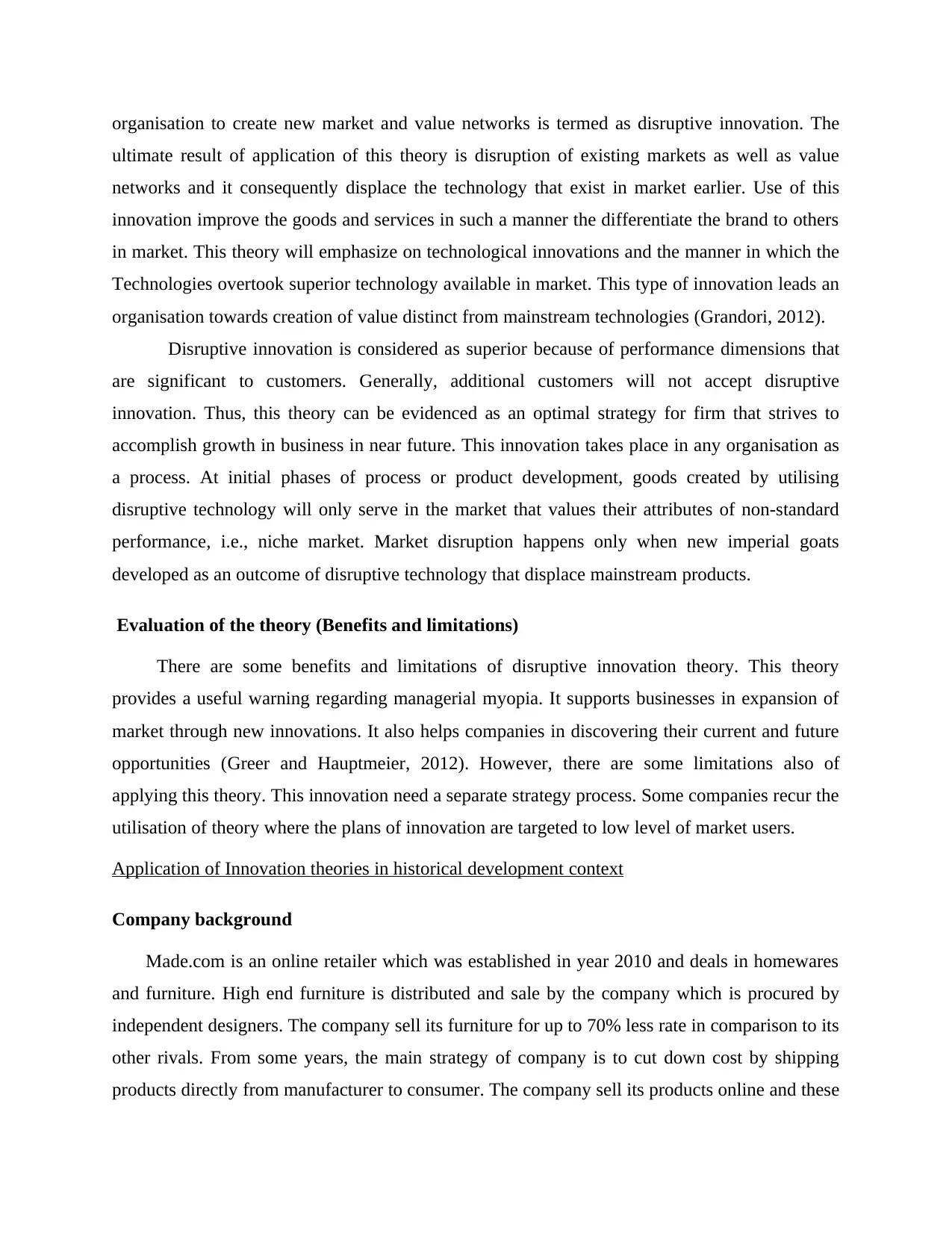
organisation to create new market and value networks is termed as disruptive innovation. The
ultimate result of application of this theory is disruption of existing markets as well as value
networks and it consequently displace the technology that exist in market earlier. Use of this
innovation improve the goods and services in such a manner the differentiate the brand to others
in market. This theory will emphasize on technological innovations and the manner in which the
Technologies overtook superior technology available in market. This type of innovation leads an
organisation towards creation of value distinct from mainstream technologies (Grandori, 2012).
Disruptive innovation is considered as superior because of performance dimensions that
are significant to customers. Generally, additional customers will not accept disruptive
innovation. Thus, this theory can be evidenced as an optimal strategy for firm that strives to
accomplish growth in business in near future. This innovation takes place in any organisation as
a process. At initial phases of process or product development, goods created by utilising
disruptive technology will only serve in the market that values their attributes of non-standard
performance, i.e., niche market. Market disruption happens only when new imperial goats
developed as an outcome of disruptive technology that displace mainstream products.
Evaluation of the theory (Benefits and limitations)
There are some benefits and limitations of disruptive innovation theory. This theory
provides a useful warning regarding managerial myopia. It supports businesses in expansion of
market through new innovations. It also helps companies in discovering their current and future
opportunities (Greer and Hauptmeier, 2012). However, there are some limitations also of
applying this theory. This innovation need a separate strategy process. Some companies recur the
utilisation of theory where the plans of innovation are targeted to low level of market users.
Application of Innovation theories in historical development context
Company background
Made.com is an online retailer which was established in year 2010 and deals in homewares
and furniture. High end furniture is distributed and sale by the company which is procured by
independent designers. The company sell its furniture for up to 70% less rate in comparison to its
other rivals. From some years, the main strategy of company is to cut down cost by shipping
products directly from manufacturer to consumer. The company sell its products online and these
ultimate result of application of this theory is disruption of existing markets as well as value
networks and it consequently displace the technology that exist in market earlier. Use of this
innovation improve the goods and services in such a manner the differentiate the brand to others
in market. This theory will emphasize on technological innovations and the manner in which the
Technologies overtook superior technology available in market. This type of innovation leads an
organisation towards creation of value distinct from mainstream technologies (Grandori, 2012).
Disruptive innovation is considered as superior because of performance dimensions that
are significant to customers. Generally, additional customers will not accept disruptive
innovation. Thus, this theory can be evidenced as an optimal strategy for firm that strives to
accomplish growth in business in near future. This innovation takes place in any organisation as
a process. At initial phases of process or product development, goods created by utilising
disruptive technology will only serve in the market that values their attributes of non-standard
performance, i.e., niche market. Market disruption happens only when new imperial goats
developed as an outcome of disruptive technology that displace mainstream products.
Evaluation of the theory (Benefits and limitations)
There are some benefits and limitations of disruptive innovation theory. This theory
provides a useful warning regarding managerial myopia. It supports businesses in expansion of
market through new innovations. It also helps companies in discovering their current and future
opportunities (Greer and Hauptmeier, 2012). However, there are some limitations also of
applying this theory. This innovation need a separate strategy process. Some companies recur the
utilisation of theory where the plans of innovation are targeted to low level of market users.
Application of Innovation theories in historical development context
Company background
Made.com is an online retailer which was established in year 2010 and deals in homewares
and furniture. High end furniture is distributed and sale by the company which is procured by
independent designers. The company sell its furniture for up to 70% less rate in comparison to its
other rivals. From some years, the main strategy of company is to cut down cost by shipping
products directly from manufacturer to consumer. The company sell its products online and these
⊘ This is a preview!⊘
Do you want full access?
Subscribe today to unlock all pages.

Trusted by 1+ million students worldwide
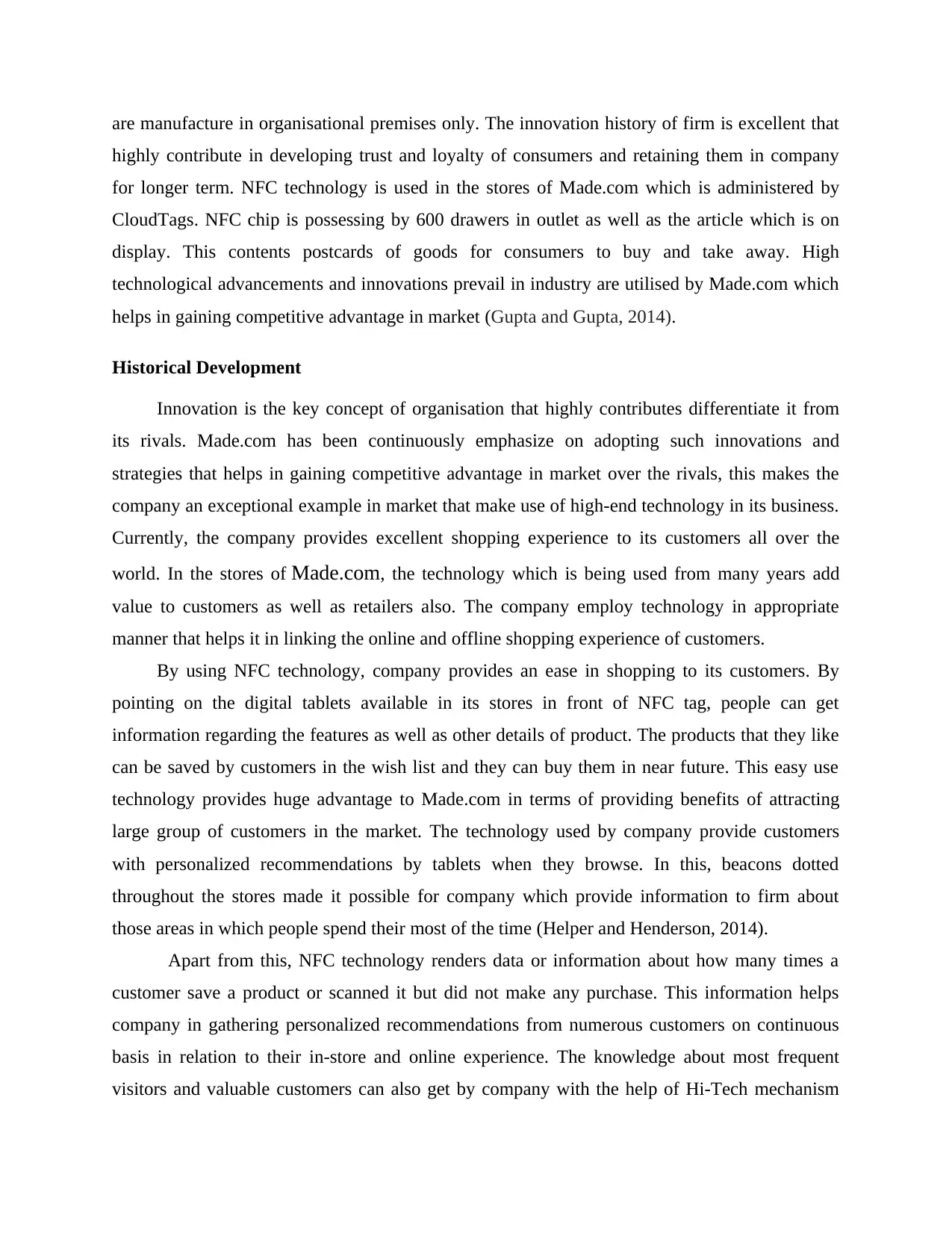
are manufacture in organisational premises only. The innovation history of firm is excellent that
highly contribute in developing trust and loyalty of consumers and retaining them in company
for longer term. NFC technology is used in the stores of Made.com which is administered by
CloudTags. NFC chip is possessing by 600 drawers in outlet as well as the article which is on
display. This contents postcards of goods for consumers to buy and take away. High
technological advancements and innovations prevail in industry are utilised by Made.com which
helps in gaining competitive advantage in market (Gupta and Gupta, 2014).
Historical Development
Innovation is the key concept of organisation that highly contributes differentiate it from
its rivals. Made.com has been continuously emphasize on adopting such innovations and
strategies that helps in gaining competitive advantage in market over the rivals, this makes the
company an exceptional example in market that make use of high-end technology in its business.
Currently, the company provides excellent shopping experience to its customers all over the
world. In the stores of Made.com, the technology which is being used from many years add
value to customers as well as retailers also. The company employ technology in appropriate
manner that helps it in linking the online and offline shopping experience of customers.
By using NFC technology, company provides an ease in shopping to its customers. By
pointing on the digital tablets available in its stores in front of NFC tag, people can get
information regarding the features as well as other details of product. The products that they like
can be saved by customers in the wish list and they can buy them in near future. This easy use
technology provides huge advantage to Made.com in terms of providing benefits of attracting
large group of customers in the market. The technology used by company provide customers
with personalized recommendations by tablets when they browse. In this, beacons dotted
throughout the stores made it possible for company which provide information to firm about
those areas in which people spend their most of the time (Helper and Henderson, 2014).
Apart from this, NFC technology renders data or information about how many times a
customer save a product or scanned it but did not make any purchase. This information helps
company in gathering personalized recommendations from numerous customers on continuous
basis in relation to their in-store and online experience. The knowledge about most frequent
visitors and valuable customers can also get by company with the help of Hi-Tech mechanism
highly contribute in developing trust and loyalty of consumers and retaining them in company
for longer term. NFC technology is used in the stores of Made.com which is administered by
CloudTags. NFC chip is possessing by 600 drawers in outlet as well as the article which is on
display. This contents postcards of goods for consumers to buy and take away. High
technological advancements and innovations prevail in industry are utilised by Made.com which
helps in gaining competitive advantage in market (Gupta and Gupta, 2014).
Historical Development
Innovation is the key concept of organisation that highly contributes differentiate it from
its rivals. Made.com has been continuously emphasize on adopting such innovations and
strategies that helps in gaining competitive advantage in market over the rivals, this makes the
company an exceptional example in market that make use of high-end technology in its business.
Currently, the company provides excellent shopping experience to its customers all over the
world. In the stores of Made.com, the technology which is being used from many years add
value to customers as well as retailers also. The company employ technology in appropriate
manner that helps it in linking the online and offline shopping experience of customers.
By using NFC technology, company provides an ease in shopping to its customers. By
pointing on the digital tablets available in its stores in front of NFC tag, people can get
information regarding the features as well as other details of product. The products that they like
can be saved by customers in the wish list and they can buy them in near future. This easy use
technology provides huge advantage to Made.com in terms of providing benefits of attracting
large group of customers in the market. The technology used by company provide customers
with personalized recommendations by tablets when they browse. In this, beacons dotted
throughout the stores made it possible for company which provide information to firm about
those areas in which people spend their most of the time (Helper and Henderson, 2014).
Apart from this, NFC technology renders data or information about how many times a
customer save a product or scanned it but did not make any purchase. This information helps
company in gathering personalized recommendations from numerous customers on continuous
basis in relation to their in-store and online experience. The knowledge about most frequent
visitors and valuable customers can also get by company with the help of Hi-Tech mechanism
Paraphrase This Document
Need a fresh take? Get an instant paraphrase of this document with our AI Paraphraser
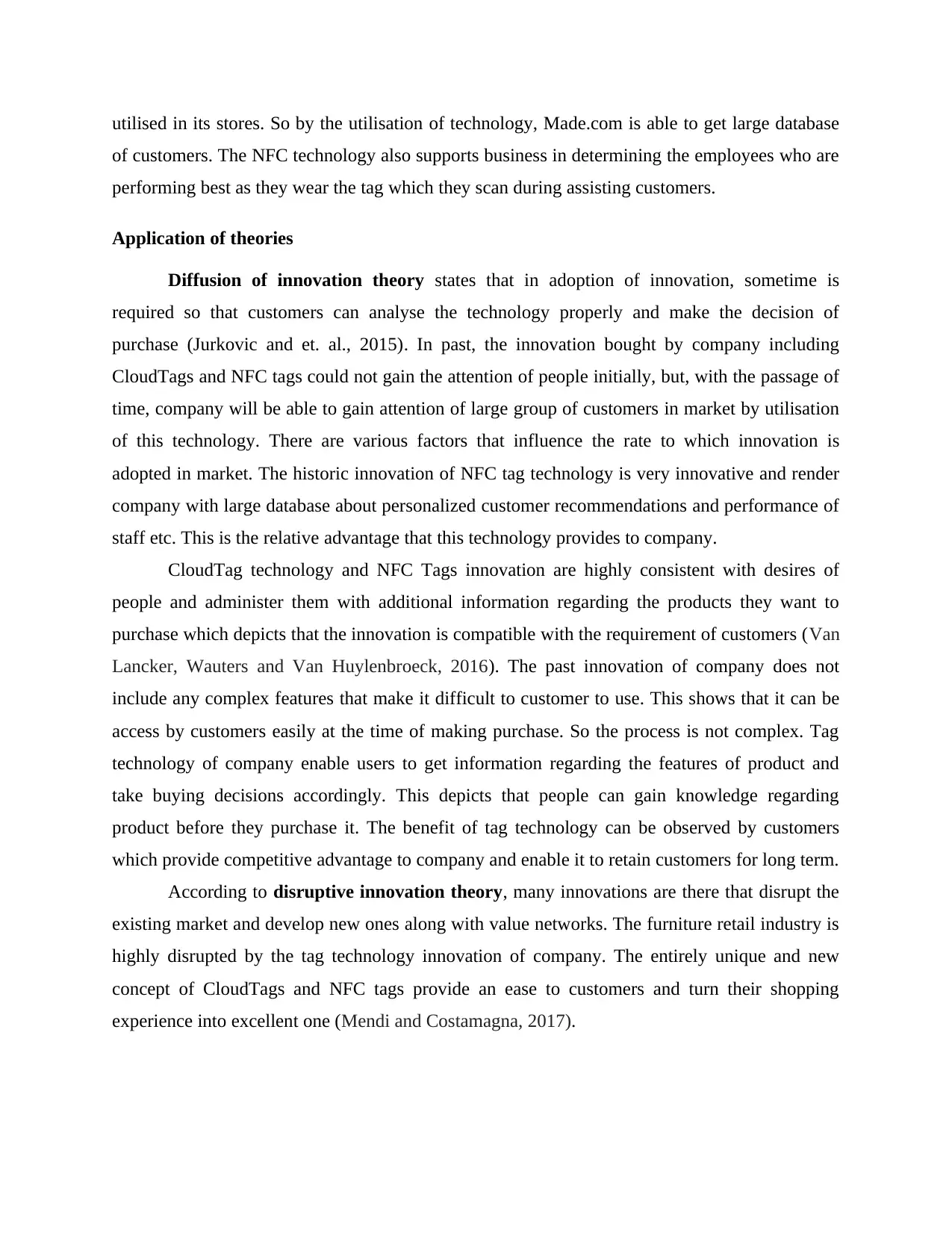
utilised in its stores. So by the utilisation of technology, Made.com is able to get large database
of customers. The NFC technology also supports business in determining the employees who are
performing best as they wear the tag which they scan during assisting customers.
Application of theories
Diffusion of innovation theory states that in adoption of innovation, sometime is
required so that customers can analyse the technology properly and make the decision of
purchase (Jurkovic and et. al., 2015). In past, the innovation bought by company including
CloudTags and NFC tags could not gain the attention of people initially, but, with the passage of
time, company will be able to gain attention of large group of customers in market by utilisation
of this technology. There are various factors that influence the rate to which innovation is
adopted in market. The historic innovation of NFC tag technology is very innovative and render
company with large database about personalized customer recommendations and performance of
staff etc. This is the relative advantage that this technology provides to company.
CloudTag technology and NFC Tags innovation are highly consistent with desires of
people and administer them with additional information regarding the products they want to
purchase which depicts that the innovation is compatible with the requirement of customers (Van
Lancker, Wauters and Van Huylenbroeck, 2016). The past innovation of company does not
include any complex features that make it difficult to customer to use. This shows that it can be
access by customers easily at the time of making purchase. So the process is not complex. Tag
technology of company enable users to get information regarding the features of product and
take buying decisions accordingly. This depicts that people can gain knowledge regarding
product before they purchase it. The benefit of tag technology can be observed by customers
which provide competitive advantage to company and enable it to retain customers for long term.
According to disruptive innovation theory, many innovations are there that disrupt the
existing market and develop new ones along with value networks. The furniture retail industry is
highly disrupted by the tag technology innovation of company. The entirely unique and new
concept of CloudTags and NFC tags provide an ease to customers and turn their shopping
experience into excellent one (Mendi and Costamagna, 2017).
of customers. The NFC technology also supports business in determining the employees who are
performing best as they wear the tag which they scan during assisting customers.
Application of theories
Diffusion of innovation theory states that in adoption of innovation, sometime is
required so that customers can analyse the technology properly and make the decision of
purchase (Jurkovic and et. al., 2015). In past, the innovation bought by company including
CloudTags and NFC tags could not gain the attention of people initially, but, with the passage of
time, company will be able to gain attention of large group of customers in market by utilisation
of this technology. There are various factors that influence the rate to which innovation is
adopted in market. The historic innovation of NFC tag technology is very innovative and render
company with large database about personalized customer recommendations and performance of
staff etc. This is the relative advantage that this technology provides to company.
CloudTag technology and NFC Tags innovation are highly consistent with desires of
people and administer them with additional information regarding the products they want to
purchase which depicts that the innovation is compatible with the requirement of customers (Van
Lancker, Wauters and Van Huylenbroeck, 2016). The past innovation of company does not
include any complex features that make it difficult to customer to use. This shows that it can be
access by customers easily at the time of making purchase. So the process is not complex. Tag
technology of company enable users to get information regarding the features of product and
take buying decisions accordingly. This depicts that people can gain knowledge regarding
product before they purchase it. The benefit of tag technology can be observed by customers
which provide competitive advantage to company and enable it to retain customers for long term.
According to disruptive innovation theory, many innovations are there that disrupt the
existing market and develop new ones along with value networks. The furniture retail industry is
highly disrupted by the tag technology innovation of company. The entirely unique and new
concept of CloudTags and NFC tags provide an ease to customers and turn their shopping
experience into excellent one (Mendi and Costamagna, 2017).
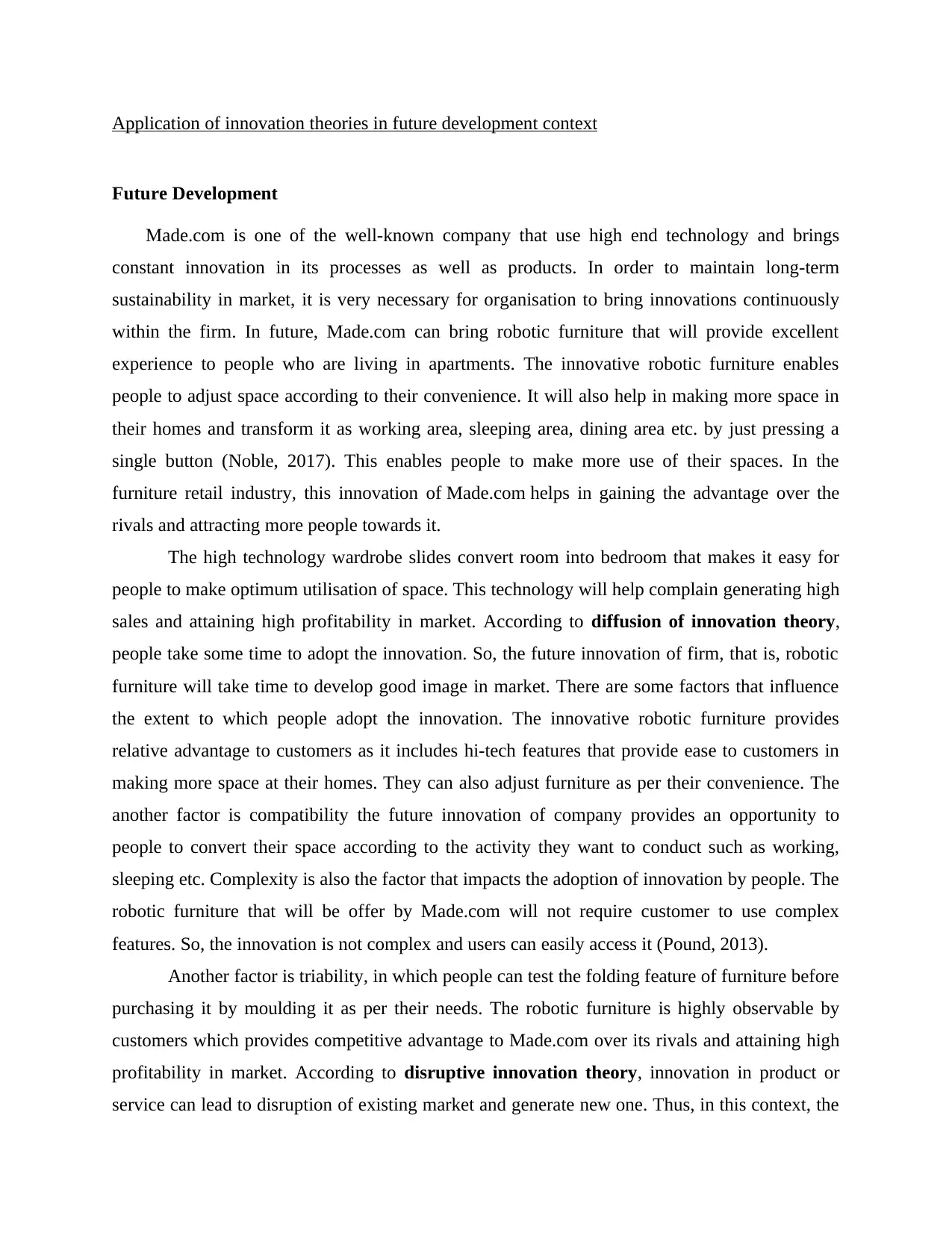
Application of innovation theories in future development context
Future Development
Made.com is one of the well-known company that use high end technology and brings
constant innovation in its processes as well as products. In order to maintain long-term
sustainability in market, it is very necessary for organisation to bring innovations continuously
within the firm. In future, Made.com can bring robotic furniture that will provide excellent
experience to people who are living in apartments. The innovative robotic furniture enables
people to adjust space according to their convenience. It will also help in making more space in
their homes and transform it as working area, sleeping area, dining area etc. by just pressing a
single button (Noble, 2017). This enables people to make more use of their spaces. In the
furniture retail industry, this innovation of Made.com helps in gaining the advantage over the
rivals and attracting more people towards it.
The high technology wardrobe slides convert room into bedroom that makes it easy for
people to make optimum utilisation of space. This technology will help complain generating high
sales and attaining high profitability in market. According to diffusion of innovation theory,
people take some time to adopt the innovation. So, the future innovation of firm, that is, robotic
furniture will take time to develop good image in market. There are some factors that influence
the extent to which people adopt the innovation. The innovative robotic furniture provides
relative advantage to customers as it includes hi-tech features that provide ease to customers in
making more space at their homes. They can also adjust furniture as per their convenience. The
another factor is compatibility the future innovation of company provides an opportunity to
people to convert their space according to the activity they want to conduct such as working,
sleeping etc. Complexity is also the factor that impacts the adoption of innovation by people. The
robotic furniture that will be offer by Made.com will not require customer to use complex
features. So, the innovation is not complex and users can easily access it (Pound, 2013).
Another factor is triability, in which people can test the folding feature of furniture before
purchasing it by moulding it as per their needs. The robotic furniture is highly observable by
customers which provides competitive advantage to Made.com over its rivals and attaining high
profitability in market. According to disruptive innovation theory, innovation in product or
service can lead to disruption of existing market and generate new one. Thus, in this context, the
Future Development
Made.com is one of the well-known company that use high end technology and brings
constant innovation in its processes as well as products. In order to maintain long-term
sustainability in market, it is very necessary for organisation to bring innovations continuously
within the firm. In future, Made.com can bring robotic furniture that will provide excellent
experience to people who are living in apartments. The innovative robotic furniture enables
people to adjust space according to their convenience. It will also help in making more space in
their homes and transform it as working area, sleeping area, dining area etc. by just pressing a
single button (Noble, 2017). This enables people to make more use of their spaces. In the
furniture retail industry, this innovation of Made.com helps in gaining the advantage over the
rivals and attracting more people towards it.
The high technology wardrobe slides convert room into bedroom that makes it easy for
people to make optimum utilisation of space. This technology will help complain generating high
sales and attaining high profitability in market. According to diffusion of innovation theory,
people take some time to adopt the innovation. So, the future innovation of firm, that is, robotic
furniture will take time to develop good image in market. There are some factors that influence
the extent to which people adopt the innovation. The innovative robotic furniture provides
relative advantage to customers as it includes hi-tech features that provide ease to customers in
making more space at their homes. They can also adjust furniture as per their convenience. The
another factor is compatibility the future innovation of company provides an opportunity to
people to convert their space according to the activity they want to conduct such as working,
sleeping etc. Complexity is also the factor that impacts the adoption of innovation by people. The
robotic furniture that will be offer by Made.com will not require customer to use complex
features. So, the innovation is not complex and users can easily access it (Pound, 2013).
Another factor is triability, in which people can test the folding feature of furniture before
purchasing it by moulding it as per their needs. The robotic furniture is highly observable by
customers which provides competitive advantage to Made.com over its rivals and attaining high
profitability in market. According to disruptive innovation theory, innovation in product or
service can lead to disruption of existing market and generate new one. Thus, in this context, the
⊘ This is a preview!⊘
Do you want full access?
Subscribe today to unlock all pages.

Trusted by 1+ million students worldwide
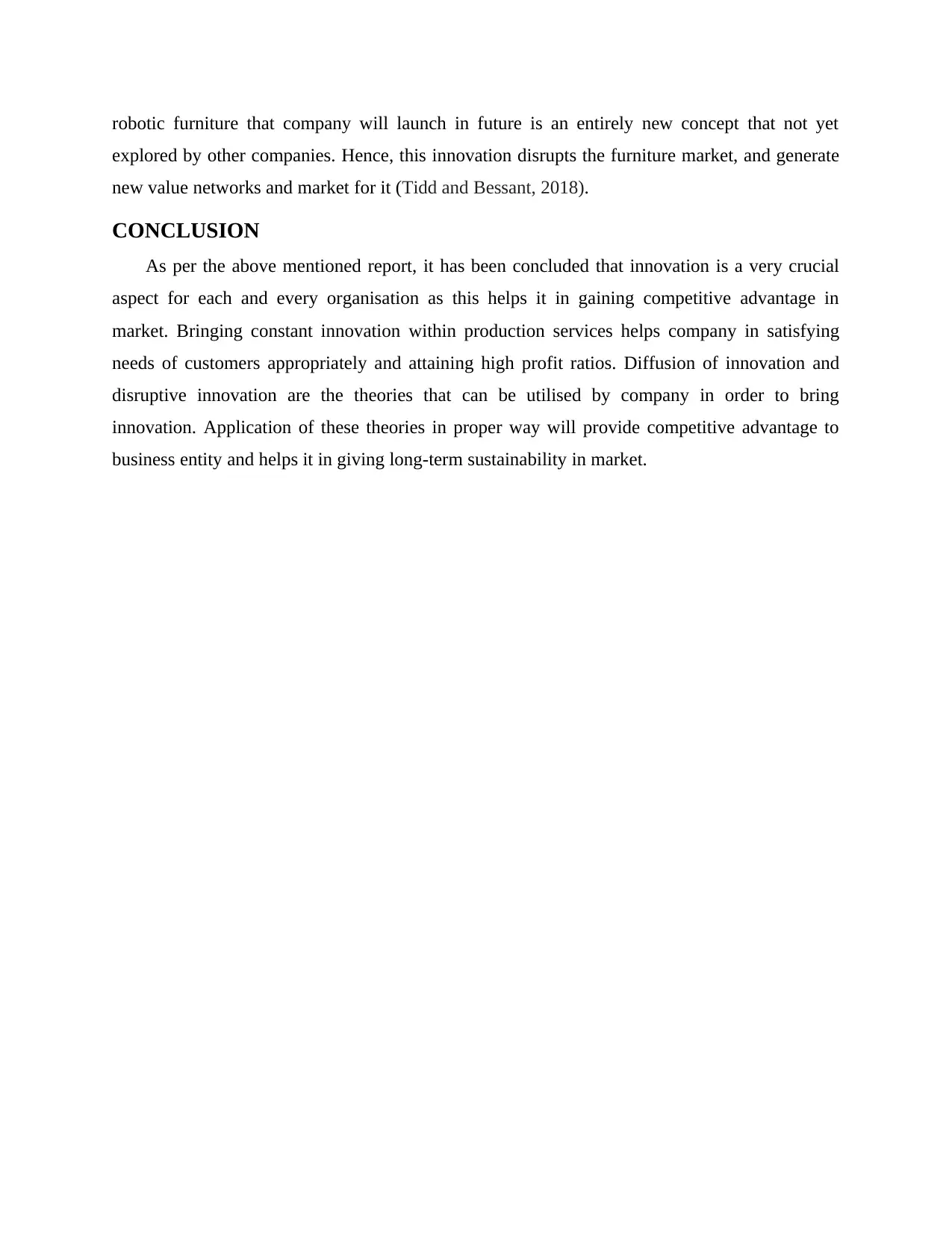
robotic furniture that company will launch in future is an entirely new concept that not yet
explored by other companies. Hence, this innovation disrupts the furniture market, and generate
new value networks and market for it (Tidd and Bessant, 2018).
CONCLUSION
As per the above mentioned report, it has been concluded that innovation is a very crucial
aspect for each and every organisation as this helps it in gaining competitive advantage in
market. Bringing constant innovation within production services helps company in satisfying
needs of customers appropriately and attaining high profit ratios. Diffusion of innovation and
disruptive innovation are the theories that can be utilised by company in order to bring
innovation. Application of these theories in proper way will provide competitive advantage to
business entity and helps it in giving long-term sustainability in market.
explored by other companies. Hence, this innovation disrupts the furniture market, and generate
new value networks and market for it (Tidd and Bessant, 2018).
CONCLUSION
As per the above mentioned report, it has been concluded that innovation is a very crucial
aspect for each and every organisation as this helps it in gaining competitive advantage in
market. Bringing constant innovation within production services helps company in satisfying
needs of customers appropriately and attaining high profit ratios. Diffusion of innovation and
disruptive innovation are the theories that can be utilised by company in order to bring
innovation. Application of these theories in proper way will provide competitive advantage to
business entity and helps it in giving long-term sustainability in market.
Paraphrase This Document
Need a fresh take? Get an instant paraphrase of this document with our AI Paraphraser
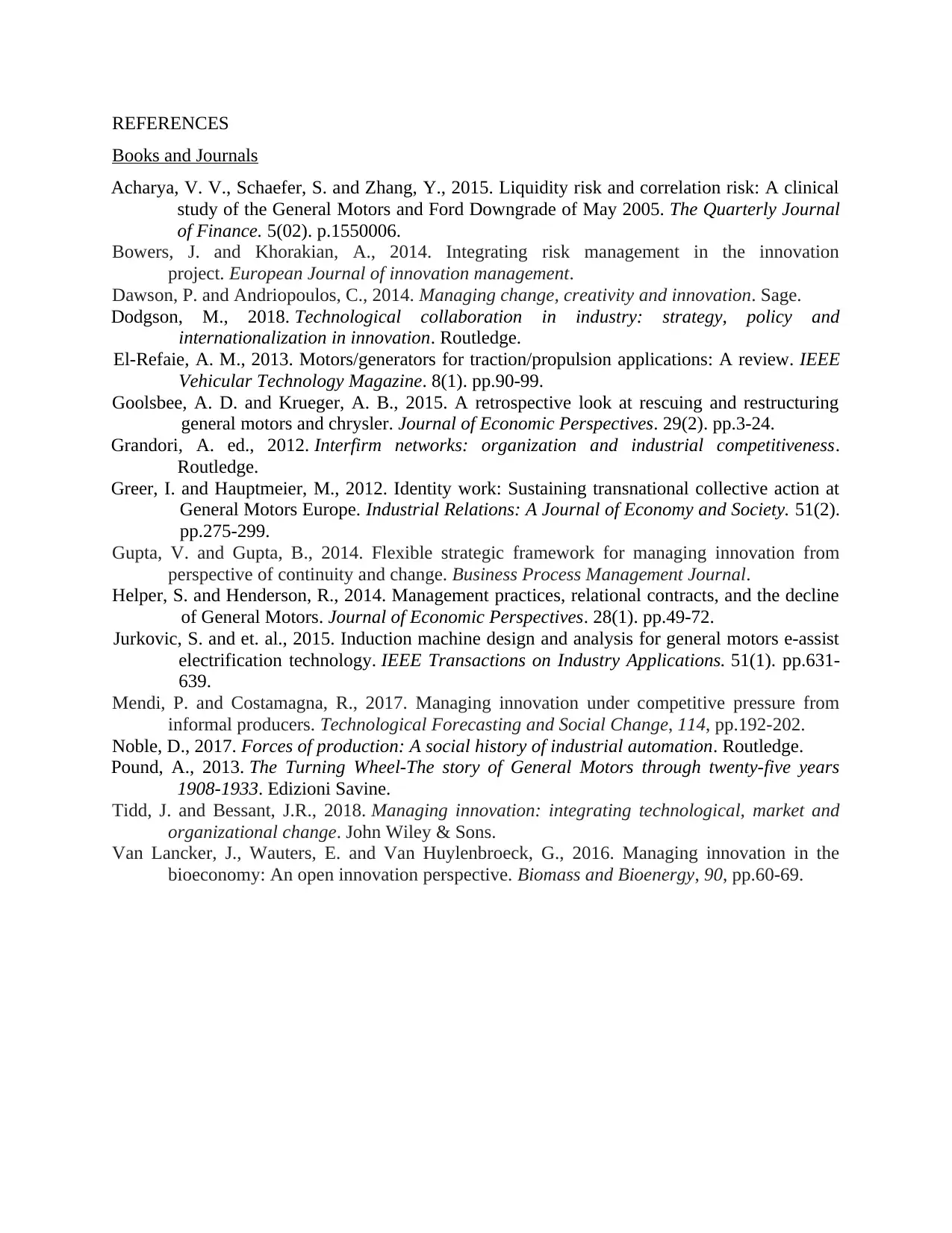
REFERENCES
Books and Journals
Acharya, V. V., Schaefer, S. and Zhang, Y., 2015. Liquidity risk and correlation risk: A clinical
study of the General Motors and Ford Downgrade of May 2005. The Quarterly Journal
of Finance. 5(02). p.1550006.
Bowers, J. and Khorakian, A., 2014. Integrating risk management in the innovation
project. European Journal of innovation management.
Dawson, P. and Andriopoulos, C., 2014. Managing change, creativity and innovation. Sage.
Dodgson, M., 2018. Technological collaboration in industry: strategy, policy and
internationalization in innovation. Routledge.
El-Refaie, A. M., 2013. Motors/generators for traction/propulsion applications: A review. IEEE
Vehicular Technology Magazine. 8(1). pp.90-99.
Goolsbee, A. D. and Krueger, A. B., 2015. A retrospective look at rescuing and restructuring
general motors and chrysler. Journal of Economic Perspectives. 29(2). pp.3-24.
Grandori, A. ed., 2012. Interfirm networks: organization and industrial competitiveness.
Routledge.
Greer, I. and Hauptmeier, M., 2012. Identity work: Sustaining transnational collective action at
General Motors Europe. Industrial Relations: A Journal of Economy and Society. 51(2).
pp.275-299.
Gupta, V. and Gupta, B., 2014. Flexible strategic framework for managing innovation from
perspective of continuity and change. Business Process Management Journal.
Helper, S. and Henderson, R., 2014. Management practices, relational contracts, and the decline
of General Motors. Journal of Economic Perspectives. 28(1). pp.49-72.
Jurkovic, S. and et. al., 2015. Induction machine design and analysis for general motors e-assist
electrification technology. IEEE Transactions on Industry Applications. 51(1). pp.631-
639.
Mendi, P. and Costamagna, R., 2017. Managing innovation under competitive pressure from
informal producers. Technological Forecasting and Social Change, 114, pp.192-202.
Noble, D., 2017. Forces of production: A social history of industrial automation. Routledge.
Pound, A., 2013. The Turning Wheel-The story of General Motors through twenty-five years
1908-1933. Edizioni Savine.
Tidd, J. and Bessant, J.R., 2018. Managing innovation: integrating technological, market and
organizational change. John Wiley & Sons.
Van Lancker, J., Wauters, E. and Van Huylenbroeck, G., 2016. Managing innovation in the
bioeconomy: An open innovation perspective. Biomass and Bioenergy, 90, pp.60-69.
Books and Journals
Acharya, V. V., Schaefer, S. and Zhang, Y., 2015. Liquidity risk and correlation risk: A clinical
study of the General Motors and Ford Downgrade of May 2005. The Quarterly Journal
of Finance. 5(02). p.1550006.
Bowers, J. and Khorakian, A., 2014. Integrating risk management in the innovation
project. European Journal of innovation management.
Dawson, P. and Andriopoulos, C., 2014. Managing change, creativity and innovation. Sage.
Dodgson, M., 2018. Technological collaboration in industry: strategy, policy and
internationalization in innovation. Routledge.
El-Refaie, A. M., 2013. Motors/generators for traction/propulsion applications: A review. IEEE
Vehicular Technology Magazine. 8(1). pp.90-99.
Goolsbee, A. D. and Krueger, A. B., 2015. A retrospective look at rescuing and restructuring
general motors and chrysler. Journal of Economic Perspectives. 29(2). pp.3-24.
Grandori, A. ed., 2012. Interfirm networks: organization and industrial competitiveness.
Routledge.
Greer, I. and Hauptmeier, M., 2012. Identity work: Sustaining transnational collective action at
General Motors Europe. Industrial Relations: A Journal of Economy and Society. 51(2).
pp.275-299.
Gupta, V. and Gupta, B., 2014. Flexible strategic framework for managing innovation from
perspective of continuity and change. Business Process Management Journal.
Helper, S. and Henderson, R., 2014. Management practices, relational contracts, and the decline
of General Motors. Journal of Economic Perspectives. 28(1). pp.49-72.
Jurkovic, S. and et. al., 2015. Induction machine design and analysis for general motors e-assist
electrification technology. IEEE Transactions on Industry Applications. 51(1). pp.631-
639.
Mendi, P. and Costamagna, R., 2017. Managing innovation under competitive pressure from
informal producers. Technological Forecasting and Social Change, 114, pp.192-202.
Noble, D., 2017. Forces of production: A social history of industrial automation. Routledge.
Pound, A., 2013. The Turning Wheel-The story of General Motors through twenty-five years
1908-1933. Edizioni Savine.
Tidd, J. and Bessant, J.R., 2018. Managing innovation: integrating technological, market and
organizational change. John Wiley & Sons.
Van Lancker, J., Wauters, E. and Van Huylenbroeck, G., 2016. Managing innovation in the
bioeconomy: An open innovation perspective. Biomass and Bioenergy, 90, pp.60-69.
1 out of 11
Related Documents
Your All-in-One AI-Powered Toolkit for Academic Success.
+13062052269
info@desklib.com
Available 24*7 on WhatsApp / Email
![[object Object]](/_next/static/media/star-bottom.7253800d.svg)
Unlock your academic potential
Copyright © 2020–2025 A2Z Services. All Rights Reserved. Developed and managed by ZUCOL.





